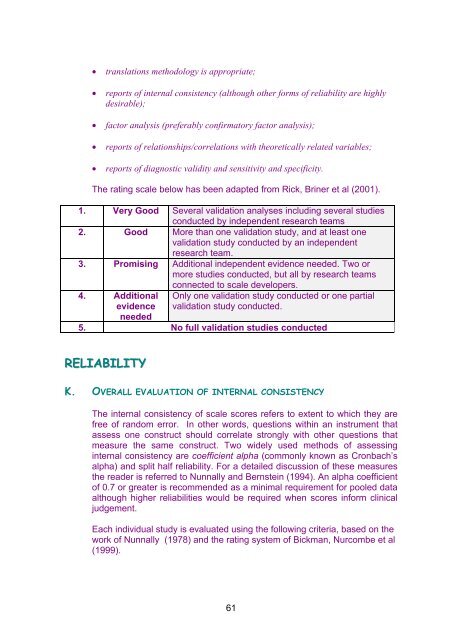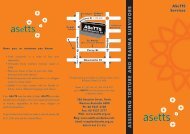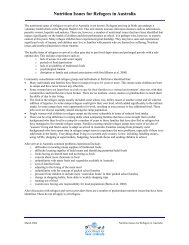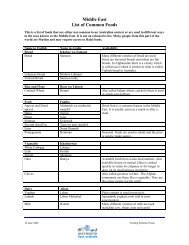Hospital Anxiety and Depression Scale (HADS): Arabic - Vacau
Hospital Anxiety and Depression Scale (HADS): Arabic - Vacau
Hospital Anxiety and Depression Scale (HADS): Arabic - Vacau
You also want an ePaper? Increase the reach of your titles
YUMPU automatically turns print PDFs into web optimized ePapers that Google loves.
• translations methodology is appropriate;<br />
• reports of internal consistency (although other forms of reliability are highly<br />
desirable);<br />
• factor analysis (preferably confirmatory factor analysis);<br />
• reports of relationships/correlations with theoretically related variables;<br />
• reports of diagnostic validity <strong>and</strong> sensitivity <strong>and</strong> specificity.<br />
The rating scale below has been adapted from Rick, Briner et al (2001).<br />
1. Very Good Several validation analyses including several studies<br />
conducted by independent research teams<br />
2. Good More than one validation study, <strong>and</strong> at least one<br />
validation study conducted by an independent<br />
research team.<br />
3. Promising Additional independent evidence needed. Two or<br />
more studies conducted, but all by research teams<br />
connected to scale developers.<br />
4. Additional<br />
evidence<br />
needed<br />
Only one validation study conducted or one partial<br />
validation study conducted.<br />
5. No full validation studies conducted<br />
RELIABILITY<br />
K. OVERALL EVALUATION OF INTERNAL CONSISTENCY<br />
The internal consistency of scale scores refers to extent to which they are<br />
free of r<strong>and</strong>om error. In other words, questions within an instrument that<br />
assess one construct should correlate strongly with other questions that<br />
measure the same construct. Two widely used methods of assessing<br />
internal consistency are coefficient alpha (commonly known as Cronbach’s<br />
alpha) <strong>and</strong> split half reliability. For a detailed discussion of these measures<br />
the reader is referred to Nunnally <strong>and</strong> Bernstein (1994). An alpha coefficient<br />
of 0.7 or greater is recommended as a minimal requirement for pooled data<br />
although higher reliabilities would be required when scores inform clinical<br />
judgement.<br />
Each individual study is evaluated using the following criteria, based on the<br />
work of Nunnally (1978) <strong>and</strong> the rating system of Bickman, Nurcombe et al<br />
(1999).<br />
61










